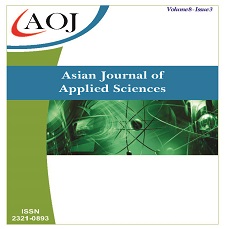Investigation Effects of Different Wind Turbine Designs on Air Flow and Generated Power
DOI:
https://doi.org/10.24203/ajas.v8i3.6243Keywords:
Wind Turbine, Dual Wind Turbine, Air Flow, Power, ShroudAbstract
This paper describes a study of different designs for the wind turbine. The basic wind turbine configuration with a second smaller rotor mounted in the front of the main rotor to extract as much force as possible from the flow. The wind turbine used in all the simulations was an upwind turbine with a 3 MW horizontal axis. The behaviors of pressures, velocities, and power generated were simulated and discussed. Three different configurations have been designed and simulated in SolidWorks at four different wind velocities ranging from 10 to 40 mph with an increment of 10 mph. The results revealed that the power generated by the rotor of the dual turbine to the rotor of the conventional turbine, the power created by the conventional turbine’s rotor is higher even though the size is the same. Furthermore, adding a diffuser equipped with a plat-type circular frame achieved the best performance. Finally, some numbers and figures are highlighted, and a conclusion is stated to summarize the results.
References
Duffie, J. A., & Beckman, W. (2013). Solar engineering of thermal processes. New Jersey: John Wiley & Sons. Inc;.
Jenkins, P. E., Younis, A., & Chen, Y. (2017). Design and Analysis of a Dual Rotor Turbine with a Shroud Using Flow Simulations. Journal of Power and Energy Engineering, 5(04), 25.
Jenkins, P. E., & Younis, A. (2016). Flow Simulation to Determine the Effects of Shrouds on the Performance of Wind Turbines. Journal of Power and Energy Engineering, 4(08), 79.
Ozbay, A., Tian, W., & Hu, H. (2014). An experimental investigation on the aeromechanics and near wake characteristics of dual-rotor wind turbines (drwts). In 32nd ASME Wind Energy Symposium (p. 1085).
Jenkins, P. E., Younis, A., & Chen, Y. (2017). Design and Analysis of a Dual Rotor Turbine with a Shroud Using Flow Simulations. Journal of Power and Energy Engineering, 5(04), 25.
Rosenberg, A. J. (2016). A computational analysis of wind turbine and wind farm aerodynamics with a focus on dual rotor wind turbines.
Nugroho, S., Diana, L., Pratilastiarso, J., Giarnayoga, W. A., & Ariyanti, D. P. (2018, October). Computational Performance and Aerodynamic Analysis of Multisage Wind turbin with Dual Rotor. In 2018 International Conference on Applied Science and Technology (iCAST) (pp. 607-612). IEEE.
Scheuermann, J. P. (2017). Wind flow through shrouded wind turbines. Naval Postgraduate School Monterey United States.
Rosenberg, A., Selvaraj, S., & Sharma, A. (2014). A novel dual-rotor turbine for increased wind energy capture. In Journal of Physics: Conference Series (Vol. 524, No. 1, p. 012078). IOP Publishing.
Jenkins, P. E., & Younis, A. (2016). Flow Simulation to Determine the Effects of Shrouds on the Performance of Wind Turbines. Journal of Power and Energy Engineering, 4(08), 79.
Sathyajith, M., & Philip, G. S. (Eds.). (2011). Advances in wind energy conversion technology. Springer Science & Business Media.
Toshimitsu, K., Narihara, T., Kikugawa, H., Akiyoshi, A., & Kawazu, Y. (2017). Experimental study of improved HAWT performance in simulated natural wind by an active controlled multi-fan wind tunnel. Journal of Thermal Science, 26(2), 113-118.
Willey, L. D. (2010). Design and development of megawatt wind turbines (pp. 206-231). Southampton, UK: WIT Press.
Green, C. (2009). Ducted or augmented turbines. Retrieved fromhttp://www.wind-works.org
Ohya, Y., & Karasudani, T. (2010). A shrouded wind turbine generating high output power with wind-lens technology. Energies, 3(4), 634-649.
Courbois, A., Flamand, O., Toularastel, J. L., Ferrant, P., & Rousset, J. M. (2011). Applying relevant wind generation techniques to the case of floating wind turbines. In Sixth European and African Conference on Wind Engineering (EACWE), Nantes, France, July (pp. 7-13).
Downloads
Published
Issue
Section
License
Copyright (c) 2020 Hazim Moria, Abdalfadel Younis, Monaem Elmnifi, Mohammad Rasidi Rasani

This work is licensed under a Creative Commons Attribution-NonCommercial 4.0 International License.
- Papers must be submitted on the understanding that they have not been published elsewhere (except in the form of an abstract or as part of a published lecture, review, or thesis) and are not currently under consideration by another journal published by any other publisher.
- It is also the authors responsibility to ensure that the articles emanating from a particular source are submitted with the necessary approval.
- The authors warrant that the paper is original and that he/she is the author of the paper, except for material that is clearly identified as to its original source, with permission notices from the copyright owners where required.
- The authors ensure that all the references carefully and they are accurate in the text as well as in the list of references (and vice versa).
- Authors retain copyright and grant the journal right of first publication with the work simultaneously licensed under a Attribution-NonCommercial 4.0 International that allows others to share the work with an acknowledgement of the work's authorship and initial publication in this journal.
- Authors are able to enter into separate, additional contractual arrangements for the non-exclusive distribution of the journal's published version of the work (e.g., post it to an institutional repository or publish it in a book), with an acknowledgement of its initial publication in this journal.
- Authors are permitted and encouraged to post their work online (e.g., in institutional repositories or on their website) prior to and during the submission process, as it can lead to productive exchanges, as well as earlier and greater citation of published work (See The Effect of Open Access).
- The journal/publisher is not responsible for subsequent uses of the work. It is the author's responsibility to bring an infringement action if so desired by the author.


